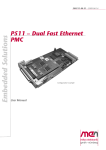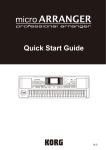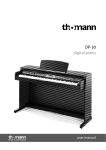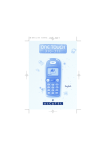Download Manual
Transcript
DP-33 digital piano user manual Musikhaus Thomann e.K. Treppendorf 30 96138 Burgebrach Germany Telephone: +49 (0) 9546 9223-0 E-mail: [email protected] Internet: www.thomann.de 05.05.2014, ID: 326890 Table of contents Table of contents 1 General notes............................................................................................................................ 1.1 Further information........................................................................................................ 1.2 Notational conventions................................................................................................. 1.3 Symbols and signal words........................................................................................... 2 Safety instructions................................................................................................................. 7 3 Features....................................................................................................................................... 9 4 Assembly instructions........................................................................................................ 10 5 Control panel and connections..................................................................................... 13 6 Connectivity options.......................................................................................................... 16 7 Switching on / off and basic operation...................................................................... 7.1 Switching the digital piano on................................................................................. 7.1.1 Normal switching on / off....................................................................................... 7.1.2 Automatic shutoff..................................................................................................... 7.2 Adjusting the volume.................................................................................................. 7.3 Demo song...................................................................................................................... 18 18 18 18 18 19 8 Functions.................................................................................................................................. 8.1 Rehearsal songs............................................................................................................. 8.1.1 Selecting, playing and stopping rehearsal songs.......................................... 8.2 Voices and effects......................................................................................................... 8.2.1 Selecting voices ......................................................................................................... 8.2.2 Dual mode.................................................................................................................... 8.2.3 Split mode.................................................................................................................... 8.2.4 Demo mode................................................................................................................. 8.2.5 Touch sensitivity........................................................................................................ 8.2.6 Digital effects.............................................................................................................. 8.2.7 Metronome.................................................................................................................. 8.2.8 Tempo............................................................................................................................ 8.2.9 Transposing................................................................................................................. 8.2.10 Fine tuning................................................................................................................ 8.2.11 Key Tone..................................................................................................................... 8.3 MIDI functions................................................................................................................ 8.3.1 What is MIDI?............................................................................................................... 8.3.2 USB connection.......................................................................................................... 8.3.3 MIDI connection......................................................................................................... 8.3.4 MIDI applications ...................................................................................................... 8.4 Troubleshooting............................................................................................................ 20 20 20 21 21 21 22 22 23 24 26 26 27 27 28 28 28 29 29 29 30 9 Rehearsal and demo songs.............................................................................................. 31 10 MIDI implementation chart............................................................................................. 33 11 Technical specifications.................................................................................................... 35 12 Plug and connection assignment................................................................................. 36 DP-33 3 5 5 5 6 Table of contents 13 Protecting the environment........................................................................................... 37 digital piano 4 General notes 1 General notes This manual contains important instructions for the safe operation of the unit. Read and follow the safety instructions and all other instructions. Keep the manual for future reference. Make sure that it is available to all those using the device. If you sell the unit please make sure that the buyer also receives this manual. Our products are subject to a process of continuous development. Thus, they are subject to change. 1.1 Further information On our website (www.thomann.de) you will find lots of further information and details on the following points: Download This manual is also available as PDF file for you to download. Keyword search Use the search function in the electronic version to find the topics of interest for you quickly. Online guides Our online guides provide detailed information on technical basics and terms. For personal consultation please contact our Personal consultation technical hotline. Service If you have any problems with the device the customer service will gladly assist you. 1.2 Notational conventions This manual uses the following notational conventions: Letterings The letterings for connectors and controls are marked by square brackets and italics. Examples: [VOLUME] control, [Mono] button. Displays Texts and values displayed on the device are marked by quotation marks and italics. Examples: ‘24ch’ , ‘OFF’ . DP-33 5 General notes Instructions The individual steps of an instruction are numbered consecutively. The result of a step is indented and highlighted by an arrow. Example: 1. Switch on the device. 2. Press [Auto]. ð Automatic operation is started. 3. Cross-references Switch off the device. References to other locations in this manual are identified by an arrow and the speci‐ fied page number. In the electronic version of the manual, you can click the crossreference to jump to the specified location. Example: See Ä ‘Cross-references’ on page 6. 1.3 Symbols and signal words In this section you will find an overview of the meaning of symbols and signal words that are used in this manual. Signal word Meaning DANGER! This combination of symbol and signal word indicates an immediate dangerous situation that will result in death or serious injury if it is not avoided. CAUTION! This combination of symbol and signal word indicates a possible dangerous situation that can result in minor injury if it is not avoided. NOTICE! This combination of symbol and signal word indicates a possible dangerous situation that can result in mate‐ rial and environmental damage if it is not avoided. Warning signs Type of danger Warning – high-voltage. Warning – danger zone. digital piano 6 Safety instructions 2 Safety instructions Intended use This device is intended to be used for electronic sound generation using a piano key‐ board. Use the device only as described in this user manual. Any other use or use under other operating conditions is considered to be improper and may result in per‐ sonal injury or property damage. No liability will be assumed for damages resulting from improper use. This device may be used only by persons with sufficient physical, sensorial, and intel‐ lectual abilities and having corresponding knowledge and experience. Other persons may use this device only if they are supervised or instructed by a person who is responsible for their safety. Safety DANGER! Danger for children Ensure that plastic bags, packaging, etc. are disposed of properly and are not within reach of babies and young children. Choking hazard! Ensure that children do not detach any small parts (e.g. knobs or the like) from the unit. They could swallow the pieces and choke! Never let children unattended use electrical devices. DANGER! Electric shock caused by short-circuit Always use proper ready-made insulated two-wire mains cabling (power cord). Do not modify the mains cable or the plug. Failure to do so could result in electric shock/death or fire. If in doubt, seek advice from a registered electrician. DANGER! Electric shock caused by high voltages inside Within the device there are areas where high voltages may be present. Never remove any covers. There are no user-serviceable parts inside. CAUTION! Possible hearing damage With loudspeakers or headphones connected, the device can produce volume levels that may cause temporary or permanent hearing impair‐ ment. Do not operate the device permanently at a high volume level. Decrease the volume level immediately if you experience ringing in your ears or hearing impairment. DP-33 7 Safety instructions CAUTION! Risk of injury due to heavy weight Due to the heavy weight of the device, at least two persons are required for transport and installation. NOTICE! Operating conditions This device has been designed for indoor use only. To prevent damage, never expose the device to any liquid or moisture. Avoid direct sunlight, heavy dirt, and strong vibrations. NOTICE! Power supply Before connecting the device, ensure that the input voltage (AC outlet) matches the voltage rating of the device and that the AC outlet is pro‐ tected by a residual current circuit breaker. Failure to do so could result in damage to the device and possibly injure the user. Unplug the device before electrical storms occur and when it is unused for long periods of time to reduce the risk of electric shock or fire. digital piano 8 Features 3 Features The digital piano is characterized by the following features: n n n n n n n n n n n n n n n n n Keyboard: 88 weighted keys with hammer action and adjustable touch response. 26 sounds 64-voice polyphony Reverb Chorus Split mode Metronome Transpose function Equalizer (3 different timbres) Music Library with 60 rehearsal songs Speaker: 2 × 15 W 3 pedals Connections: 2 × headphones out, stereo AUX IN/OUT, USB MIDI 2.0 Weight: 37 kg Dimensions (W × D × H): 1365 × 330 × 790 mm Finish: matt black Automatic switchoff DP-33 9 Assembly instructions 4 Assembly instructions You need a Phillips screwdriver (not supplied) for the assembly of the digital piano. Open the package and please make sure before assembling that the entire scope of delivery is present, as posted here. 1. Digital piano housing 8. Pedal box with rear panel 2. Left side panel 9. Phillips-head screws 6 ´ 50 (8 pcs.) 3. Left speaker box 10. Screw caps (8 pcs.) 4. Speaker cable 11. Right side panel 5. Right speaker box 12. Phillips-head barrel nuts (4 pcs.) 6. Pedal cable 13. Phillips-head screws 4 ´ 15 (2 pcs.) 7. Hand screws (2 pcs.) 14. Seals (2 pcs.) Mechanical assembly 1. Proceed according to the illustrations and exclusively use the supplied screws. Using other screws could damage the digital piano housing or the speaker boxes or result in a reduced stability of the digital piano. n (7) Hand screws (2 pcs.) n (9) Phillips-head screws 6 ´ 50 (8 pcs.) and n (11) Phillips-head screws 4 ´ 15 (2 pcs.) digital piano 10 Assembly instructions 2. Insert the four Phillips-head barrel nuts (12) into the rear panel of the pedal box (8) as shown in the left part of the figure. Use two screws 6 ´ 50 (9) on each side to attach the two side panels to the pedal box and cover the four screws with screw caps (10). 3. Attach the speakers with each two screws 6 ´ 50 (9) to the side panels (2) and (11) and cover the screws with screw caps (10). 4. Put the digital piano housing (1) on the stand and affix it using the two hand screws (7). DP-33 11 Assembly instructions 5. Use the two screws 4 ´ 15 (13) and the seals (14) to attach the speaker boxes. Connect the speaker cable (4) and pedal cable (5) according to the labels. Move the digital piano to its designated location. 1. Make sure that the device is turned off before you connect it to the power supply or disconnect it. 2. Turn the volume knob counter-clockwise to minimum before connecting the digital piano to the power supply or to other devices. This is to protect the speakers from damage. 3. Connect the cable from the power adapter outlet to the input socket [DC IN] on the rear panel of the digital piano. Connecting the power supply Plug the AC power cord into a properly wired mains wall outlet. digital piano 12 Control panel and connections 5 Control panel and connections Control panel left and right 1 Rotary control [VOLUME] to set the volume. 2 [START/STOP] button to playback rehearsal songs. 3 [FUNCTION] button. Press and hold this key while you call up a specific func‐ tion with a piano key. 4 [DEMO L – R] button. In [SONG] mode, you can use it to select the left or right hand. 5 Piano keys [VOICE] for sound selection. Keep the [FUNCTION] button pressed and select the desired sound with one of the piano keys. 6 Piano keys [SONG] to select rehearsal songs. Keep the [FUNCTION] button pressed and select the desired practise song with the piano keys. 7 Piano keys [TEMPO] to adjust the tempo. Keep the [FUNCTION] button pressed and select the desired tempo with the piano keys. 8 Piano keys [METRONOME] to adjust the metronome and the time signature. Keep the [FUNCTION] button pressed and press the piano key [ON/OFF] to turn the metronome on or off. Keep the [FUNCTION] button pressed and press one of the other piano keys to adjust the time signature. 9 Piano keys [REVERB] to adjust the Reverb effect and the effects depth. Keep the [FUNCTION] button pressed and press the piano key [OFF] to turn the Reverb effect off. Keep the [FUNCTION] button pressed and press one of the other piano keys to adjust the effects depth. DP-33 13 Control panel and connections 10 Piano keys [CHORUS] to adjust the Chorus effect and the effects depth. Keep the [FUNCTION] button pressed and press the piano key [OFF] to turn the Chorus effect off. Keep the [FUNCTION] button pressed and press one of the other piano keys to adjust the effects depth. 11 Piano keys [TOUCH] to adjust the touch sensitivity. Keep the [FUNCTION] button pressed and select the desired touch sensitivity with one of the piano keys. 12 Piano keys [EQ] to adjust the timbre. Keep the [FUNCTION] button pressed and select the desired timbre with one of the piano keys. 13 Piano keys [TRANSPOSE] to transpose the note values. Keep the [FUNCTION] button pressed and transpose the note value by up to 12 semitones up or downwards using the [+] or [–] buttons. 14 Piano keys [TUNE] to fine tune the entire keyboard. Keep the [FUNCTION] button pressed and tune up or downwards in 2-cent increments using the piano keys [+] or [–]. 15 Piano key [VOICE DEMO]. Keep the [FUNCTION] button pressed and press the piano key [VOICE DEMO] to play the demo song. 16 Piano key [BEEP]. Keep the [FUNCTION] button pressed and press the piano key [BEEP] to turn the beep sound on pressing the function button on or off. Pedals 17 Soft-Pedal Using the Soft-Pedal softens the sound and reduces the overall volume. 18 Sostenuto-Pedal Depressing the Sostenuto-Pedal while striking a note or notes will hold those until the pedal is released. 19 Sustain-Pedal The Sustain-Pedal emulates the effect achieved lifting the string damper of an analog piano. All striked notes will sound longer. Rear panel connections 20 AUX IN Input for external audio devices like MP3 or CD players, playback via internal speakers. AUX OUT Output for external audio devices like active speakers or amplifiers. 21 DC IN Connection for the power adapter digital piano 14 Control panel and connections 22 SPEAKER Connection for speaker cable 23 PEDAL Connection for pedal cable Piano keys The keyboard keys are referred to in this manual as shown below. DP-33 15 Connectivity options 6 Connectivity options Headphones To the left beneath the keyboard you find the headphones outlets 1 and 2. Connecting headphones (not supplied) to outlet 2 mutes the speakers. Using outlet 1 maintains the sound output through the speakers. External audio devices via the AUX OUT socket Use the AUX OUT socket to connect the digital piano to an amplifier, stereo device, mixing console or recording device. Plug one end of the audio cable into the AUX OUT socket on the rear panel of the digital piano and the other end into the input of the respective audio device. NOTICE! To prevent damage to the speakers, turn the volume down to ‘Min‐ imum’ before you connect other devices to the digital piano. External audio devices via the AUX IN socket Use the AUX IN socket to connect a, for example, CD or MP3 player to the digital piano. So you can playback music through the internal speakers of the digital piano and simultaneously play along to it. Plug one end of the audio cable into the AUX IN socket on the rear panel of the digital piano and the other end into the output of the respective audio device. digital piano 16 Connectivity options Computer n USB/MIDI interface MIDI data is sent and received through the USB/MIDI interface. n MIDI connections MIDI stands for ‘Musical Instrument Digital Interface’ and represents a global standard for the communication of numerous electronic instruments and sound modules. – MIDI IN: The device receives MIDI data from other devices through this port. – MIDI OUT: MIDI data generated by the digital piano is sent to other MIDI devices through this port. DP-33 17 Switching on / off and basic operation 7 Switching on / off and basic operation 7.1 Switching the digital piano on 7.1.1 Normal switching on / off To turn the digital piano on or off, use the [On / Off] button located besides the head‐ phones outlet on the bottom side (left) of the keyboard. 7.1.2 Automatic shutoff If the digital piano is not in use, it shuts off after 30 minutes automatically. To turn it back on, press the On/Off button. By default, the automatic shutoff function gets initialized when you turn on the unit. To disable the function, keep the first left white key on the keyboard pressed while turning the unit on. 7.2 Adjusting the volume Adjust the rotary control [VOLUME] for a pleasant volume for playback and rehearsal. Turn this control clockwise to increase the volume. Turn it counter-clockwise to reduce the volume. digital piano 18 Switching on / off and basic operation 7.3 Demo song The built-in demo song shows the sound and the pitch range of the instrument. 1. Simultaneously press the buttons [FUNCTION] and [DEMO L – R] to start the playback of the demo song. At the same time, all the LEDs flash on the control panel. The demo song is playing in an endless loop. 2. Press the buttons [FUNCTION] and [DEMO L – R] again or the [START/STOP] button, to stop playback and exit the current mode. 3. During playback, the piano keys are muted. DP-33 19 Functions 8 Functions 8.1 Rehearsal songs 8.1.1 Selecting, playing and stopping rehearsal songs The digital piano offers 60 rehearsal songs for practising in total (seeÄ Chapter 9 ‘Rehearsal and demo songs’ on page 31). 1. Keep the button [FUNCTION] pressed and press the [ START/STOP] button, to enter the playback mode for rehearsal songs. All rehearsal songs are played in an endless loop. 2. Press the [START/STOP] button, to stop the currently playing rehearsal song. This will not quit the mode for rehearsal song playback [SONG]. If you press the [START/STOP ] button again, this song is repeated in an endless loop until you press the [START/STOP] button again. 3. Selecting rehearsal songs Keep the [FUNCTION] button pressed and press the respective piano key in the [SONG] area to select the desired rehearsal song. – – 4. Press the piano keys [+] and [–] simultaneously to select the first rehearsal song. To select the rehearsal song with the numeric keys, always enter the number in two-digit format. If you want to select the eighth rehearsal song, for example, press the piano keys [0] [8]. Practising left and / or right hand. In [SONG] mode, you can repeatedly press the [L – R] buttons, to select either both tracks of the rehearsal songs for playback, or only the left or right track, so that you can practise your hands individually or both together. The setting is indicated by the LEDs. digital piano 20 Functions 8.2 Voices and effects 8.2.1 Selecting voices You can call up to 26 voices via the piano keys in the [VOICE] area. Each piano key in the [VOICE] area is assigned to two voices. With the first keystroke you activate the voice that is given in the first row above the button, with the second keystroke you activate the voice that is specified in the second line above the key. 1. Keep the [FUNCTION] button pressed and press the desired piano key in the [VOICE] area. 2. To select a different voice, keep the [FUNCTION] button pressed and press the desired piano key in the [VOICE] area. Depending on whether the previously selected voice is shown in the first or second line above the piano key, when changing the voice that voice is selected that is specified in the corresponding line above the piano key. When selecting a voice, Dual and Split mode will automatically be disabled. 8.2.2 Dual mode In Dual mode, you can play two voices simultaneously. Keep the [FUNCTION] button pressed and press the two desired piano keys in the [VOICE] area. Select the first voice with the first piano key and the second voice with the second piano key. If Dual mode is selected, the Split mode is automatically switched off. DP-33 21 Functions 8.2.3 Split mode With this function, you can assign different voices to certain keyboard areas. Keep the [FUNCTION] button pressed and press the piano key [Lower] in the [VOICE] area. This splits the keyboard automatically into two areas with dif‐ ferent voices. A string voice is assigned to the piano keys in the left section of the keyboard up to and including [F#3]. 8.2.4 Demo mode The digital piano offers 26 demos for the individual voices. Keep the [FUNCTION] button pressed and press the piano key [VOICE DEMO] to start the demo for the selected voice. Press this piano key again to exit the demo mode. In demo mode, the piano keys can not be played. digital piano 22 Functions 8.2.5 Touch sensitivity With this function you can adjust the touch response of the keyboard at four dif‐ ferent levels. Parameter Description [OFF] Touch sensitivity is off. This can be very recom‐ mendable when playing the organ voice. [1] Soft In this setting, the volume is higher than usual even when playing with a soft touch. [2] Normal This setting corresponds to the usual touch response of a keyboard. [3] Hard In this setting, the volume is lower than usual even when playing with a hard touch. Keep the [FUNCTION] button pressed and press one of the piano keys in the [TOUCH] area to adjust the touch sensitivity. DP-33 23 Functions 8.2.6 Digital effects 8.2.6.1 Reverb and Chorus With the reverb and chorus functions you can simulate acoustic effects under dif‐ ferent environmental conditions. Keep the [FUNCTION] button pressed and press one of the piano keys in the [REVERB] or [CHORUS] area to adjust the desired effect. Piano key in the [REVERB] area in the [CHORUS] area [OFF] No Reverb No Chorus [1] Chamber Slight Chorus effect [2] Small hall Medium Chorus effect [3] Large hall Strong Chorus effect [4] Stadium Flanger effect digital piano 24 Functions 8.2.6.2 Equalizer effect The equalizer function allows three different settings. Keep the [FUNCTION] button pressed and press one of the piano keys in the [EQ] area to adjust the desired effect. Piano key Equalizer setting [1] Standard [2] Classic [3] Modern DP-33 25 Functions 8.2.7 Metronome 1. Turning the metronome on / off Keep the [FUNCTION] button pressed and press the piano key [ON/OFF] in the [METRONOME ] area to turn the metronome on or off. 2. Setting the time signature Keep the [FUNCTION] button pressed and press one of the piano keys [0], [2], [3], [4], [5], [6] in the [METRONOME ] area to set the desired time signature. 3. Setting the metronome sound Keep the [FUNCTION] button pressed and press the piano key [VOCAL] in the [METRONOME ] area to set a human voice or the click sound as the metronome sound. 8.2.8 Tempo Keep the [FUNCTION] button pressed and press the respective piano key in the [TEMPO] area to set the desired Tempo. You can set the Tempo by pressing the piano key [TAP] twice, or using the piano keys [+] and [–] or using the piano keys [0] to [9]. – – – If you press the buttons [+] and [–] in the [TEMPO] area simultaneously, the Tempo will be reset to the default standard value (120 beats per minute). The tempo can be adjusted in a range from 30 to 280 bpm. If you want to change the tempo with the piano keys [0] to [9], you always have to enter it in three-digit format. For example, to set tempo 85, you have to press the piano keys [0][8][5] in a row in the [TEMPO] area. digital piano 26 Functions 8.2.9 Transposing With this function you can adjust the pitch of the keyboard in 12 semitone steps up or down. Keep the [FUNCTION] button pressed and press the piano keys [+] and [–] in the [TRANSPOSE] area to adjust the keyboard pitch in semitone steps up or down. – 8.2.10 Press the [+] and [–] buttons in the [TRANSPOSE] area simultaneously to restore the default setting (no transposition). Fine tuning With this function you can fine tune the entire keyboard in 0.2-Hz steps. Keep the [FUNCTION] button pressed and press the piano keys [+] and [–] in the [TUNE] area to fine tune the keyboard. The value changes by 0.2 Hz in a range from –100 to +100 Hz per keystroke. – Press the [+] and [–] buttons in the [TUNE] area simultaneously to restore the default setting (0 Hz). DP-33 27 Functions 8.2.11 Key Tone With this function, you can turn the Key Tone on or off. By default, the Key Tone is turned on. Keep the [FUNCTION] button pressed and press the piano key [BEEP] to turn the Key Tone on or off. If you keep the [FUNCTION] button pressed and turn on the Key Tone, you will hear a beep tone every time you press a function button. 8.3 MIDI functions 8.3.1 What is MIDI? 1. MIDI stands for ‘Musical Instrument Digital Interface’ and represents the standard interface between a computer and electronic instruments. 2. You can use the USB connection to exchange MIDI data with computers or other USB devices that support USB audio via USB cable. 3. The digital piano can be connected to computers or other USB devices. 4. MIDI data from computers or other USB devices can be played back by the sound module of the piano. digital piano 28 Functions 8.3.2 USB connection 1. System requirements n n n n 2. CPU: 300 MHz, Pentium 2 or higher. RAM: 64 MB min. 2 MB free hard disc space. Operating system: Windows® 2000/XP, Vista, Windows 7, Windows 8. Connecting Connect the USB port on the rear panel of the digital piano to the USB port on your computer using a standard USB cable (not included). 3. USB precautions Please heed the following instructions when connecting USB instruments to computers. Otherwise, the instrument or the computer may ‘crash’, which can result in data loss. If a ‘crash’ should occur, turn off computer and instrument and restart them after a few seconds. – – If the computer is in standby or hibernation, wake the computer before connecting the USB cable. Establish the USB connection between computer and instrument before turning on the instrument. 8.3.3 MIDI connection 1. Tips on connecting At MIDI connections, the device that controls other devices, is referred to as the ‘Master’. A device that is controlled via MIDI is called ‘Slave’. Connect the MIDI OUT of the master to the MIDI IN of the slave. You can not connect the MIDI OUT of a device to the MIDI IN of the same device. 2. Connection method Connect the MIDI interface to the computer. 3. Additional devices Connect additional devices via the MIDI interface. 8.3.4 MIDI applications n The digital piano can control other equipment or electronic instruments. n You can use other devices to control the digital piano. n The digital piano can play MIDI files from a computer. DP-33 29 Functions 8.4 Troubleshooting Problem Possible causes and solutions You hear a 'pop' sound from the speakers when switching the digital piano on and off. This is normal. No need to worry. No sound can be heard when playing the piano. Make sure that the volume control is set appropriately. Check if headphones are plugged into the headphone output 2. Connecting headphones will mute the speakers of the dig‐ ital piano. Malfunction occurs when using a mobile phone. Using a mobile phone near the digital piano can cause inter‐ ference. To prevent this, turn off the mobile phone or use it only at a safe distance. digital piano 30 Rehearsal and demo songs 9 Rehearsal and demo songs No. Name No. Name 1 Waltz in A Flat Op.39, No.15 31 Mazurka 2 The Happy Farmer 32 Minuet 1 3 Etude 33 Minuet 2 4 Dance Of The Four Swans From ‘Swan Lake’ 34 Minuet 3 5 Carmen Suite No.2 Habanera 35 Minuet In G 6 A Little Polish Dance 36 Neapolitan Song 7 Jesus Saviour Pilot Me 37 Prelude 8 Old Macdonald Had A Farm 38 Salut D' Amour 9 O Sole Mio 39 Pizzicato Polka 10 Wedding March From ‘Lohengrin’ 40 Piano Sonata No.11 in A major KV 331, Andante grazioso 11 2-Part Invention No.13 In A Minor BWV 784 41 Songs Without Words Op30 No. 6 F sharp minor Vene‐ tian Gondola Song 12 Turkish March 42 Duke Aria From ‘The Rigoletto’ 13 Italian Polka 43 Burgmuller Op.100 No.15 - Ballade 14 Musette 44 Spinning Song 15 Bourree 45 In The Theatre 16 To A Wild Rose 46 Alfredo and Violetta Column Tower Duet 17 Away In A Manger 47 Come Back To Sorrento 18 Für Elise 48 Piano Sonatina In F Major 19 Marriage Of Figaro 49 Tchaikovsky Waltz 20 Angels We Have Heard On High 50 Military March No.1 In D Major 21 Waltz 51 Als die alte Mutter mich noch lehrte singen 22 America The Beautiful 52 Etude on Leger Lines 1 23 Did You Ever See A Lassie 53 Etude on Leger Lines 2 24 Arabesque 54 At the Ball 25 Old France 55 Dancing Raindrops 26 Santa Claus Is Coming To Town 56 From a Story Book 27 Music Box Dancer 57 Comin' 'Round the Mountain 28 Symphony No.9 In E Minor Largo From ‘The New World’ 58 Song of the Brook 29 Larghetto 59 Puck 30 French Suites 60 Cotton-pickin' Fingers DP-33 31 Rehearsal and demo songs Demo song No. Name 1 Fantasia digital piano 32 MIDI implementation chart 10 MIDI implementation chart Function Basic Channel Mode Sent Received Default 1 ALL Changed 1-16 1-16 Default No Mode 3 Messages No Mode 3 Altered ******** No 0 – 127 0 – 127 True voice ******** 0 – 127 Note ON Yes, 9nH, Yes, 9nH, v = 1 – 127 v = 1 – 127 No, 9nH, Yes, 9nH, v=0 v = 0 or 8nH, v = 0 – 127 Keys No No Channels No No No Yes Note Number Velocity Note Note OFF After Touch Pitch Bend Notes DP-33 33 MIDI implementation chart Function Control Change Program Change Sent Received Notes 0 Yes Yes Bank Select 1 No Yes Modulation 5 No Yes Portamento Time 6 Yes Yes Data Entry 7 Yes Yes Volume 10 No Yes Pan 11 No Yes Expression 64 Yes Yes Sustain Pedal 65 No Yes Portamento ON/OFF 66 Yes Yes Sostenuto Pedal 67 Yes Yes Soft Pedal 80 No Yes Reverb Program 81 No Yes Chorus Program 91 Yes Yes Reverb Level 93 Yes Yes Chorus Level 120 No Yes All Sound Off 121 No Yes Reset All Controllers 123 Yes Yes All Notes Off True # Yes Yes ******** 0 – 127 No Yes Song Position Pointer No No Song Select No No Tune Request No No Clock No No Commands No No Local ON/OFF No No ALL Notes OFF Yes Yes Active Sensing Yes Yes System Reset No Yes System Exclusive System Common System Real Time Aux Messages MIDI channel modes POLY MONO OMNI ON Mode 1 Mode 2 OMNI OFF Mode 3 Mode 4 digital piano 34 Technical specifications 11 Technical specifications Keyboard 88 weighted keys with hammer action and adjustable touch response Polyphony 64-voice Voices 26 Rehearsal songs 60 Demo songs 1 Operating elements On / Off switch, Volume control, Start / Stop button, Piano function keys to select Voices, Demo and Rehearsal songs, Dual mode, Split mode, Tempo, Metronome, Reverb and Chorus effect, Velocity sensitivity, Transposition, Fine tune, Equalizer settings, Key Tone. Pedals Soft, Sostenuto, Sustain Connections DC IN, 2 × head phones (1/4" phone jack), AUX IN, AUX OUT, USB Speaker 2 × 15 W Operating supply voltage 230 V Dimensions (W × D × H) 1365 mm × 330 mm × 790 mm Weight 37 kg (AC) DP-33 35 Plug and connection assignment 12 Plug and connection assignment Introduction This chapter will help you select the right cables and plugs to connect your valuable equipment in such a way that a perfect sound experience is ensured. Please note these advices, because especially in ‘Sound & Light’ caution is indicated: Even if a plug fits into the socket, an incorrect connection may result in a destroyed power amp, a short circuit or ‘just’ in poor transmission quality! Balanced and unbalanced transmis‐ sion Unbalanced transmission is mainly used in semi-professional environment and in hifi use. Instrument cables with two conductors (one core plus shielding) are typical rep‐ resentatives of the unbalanced transmission. One conductor is ground and shielding while the signal is transmitted through the core. Unbalanced transmission is susceptible to electromagnetic interference, especially at low levels, such as microphone signals and when using long cables. In a professional environment, therefore, the balanced transmission is preferred, because this enables an undisturbed transmission of signals over long distances. In addition to the conductors ‘Ground’ and ‘Signal’, in a balanced transmission a second core is added. This also transfers the signal, but phase-shifted by 180°. Since the interference affects both cores equally, by subtracting the phase-shifted signals, the interfering signal is completely neutralized. The result is a pure signal without any noise interference. 1/4" TRS phone plug (stereo, unbal‐ anced) 1 Signal (left) 2 Signal (right) 3 Ground 1 Signal (left) 2 Signal (right) 3 Ground, shielding Three-pole 1/8" mini phone jack (stereo, unbalanced) digital piano 36 Protecting the environment 13 Protecting the environment Disposal of the packaging material For the transport and protective packaging, environmentally friendly materials have been chosen that can be supplied to normal recycling. Ensure that plastic bags, packaging, etc. are properly disposed of. Do not just dispose of these materials with your normal household waste, but make sure that they are collected for recycling. Please follow the notes and markings on the packaging. Disposal of your old device This product is subject to the European Waste Electrical and Electronic Equipment Directive (WEEE). Do not dispose with your normal household waste. Dispose of this device through an approved waste disposal firm or through your local waste facility. When discarding the device, comply with the rules and regulations that apply in your country. If in doubt, consult your local waste disposal facility. DP-33 37 Notes digital piano 38 Musikhaus Thomann e.K. · Treppendorf 30 · 96138 Burgebrach · Germany · www.thomann.de








































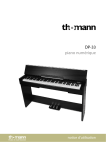
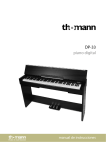
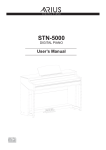

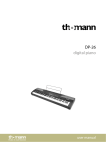
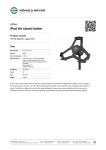
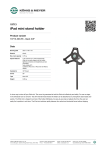

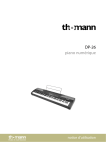
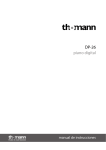
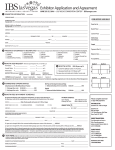
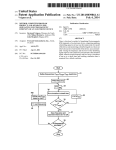
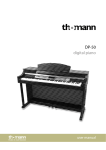

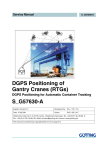
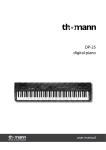
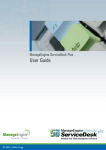
![Overture 2 Owner`s Manual [US]](http://vs1.manualzilla.com/store/data/005690862_1-0f7bb48baaf3473aa086657512069e12-150x150.png)
